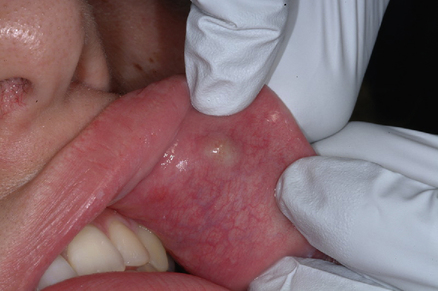Salivary neoplasms
INTRODUCTION
The wide range of different neoplasms that can affect the salivary glands has been classified by the World Health Organization (Box 49.1). The epithelial neoplasms, which are the most important, can be memorized by the mnemonic ‘A Most Acceptable Classification’ – most are benign but some are malignant (Tables 49.1 and 49.2):
Table 49.1
The more common benign salivary gland epithelial neoplasms
| Neoplasm | Comment |
| Pleomorphic salivary adenoma (PSA) | Most common |
| Warthin tumour | Second most common benign neoplasm; associated with tobacco smoking; often multiple, sometimes bilateral; frequency increasing |
| Myoepithelioma | Rare |
| Basal cell adenoma | Older patients affected |
| Oncocytoma | Older patients affected May follow irradiation May be bilateral |
| Canalicular adenoma | Most common in upper lip, and in older patients |
Table 49.2
The more common malignant salivary gland epithelial neoplasms
| Neoplasm | Comment |
| Carcinoma ex-PSA | Variable prognosis |
| Acinic cell carcinoma | Mainly in parotid Poor prognosis |
| Mucoepidermoid carcinoma | Most common malignancy |
| Adenoid cystic carcinoma | Poor prognosis |
| Polymorphous low grade adenocarcinoma | Most are seen in palate; good prognosis |
| Epithelial-myoepithelial carcinoma | Most in major glands; variable prognosis |
 Mucoepidermoid tumour: intermediate level of malignancy (see below)
Mucoepidermoid tumour: intermediate level of malignancy (see below)
 Acinic cell tumour: intermediate malignancy (see below)
Acinic cell tumour: intermediate malignancy (see below)
 Carcinomas such as adenoid cystic carcinoma, polymorphous low grade adenocarcinoma, and others.
Carcinomas such as adenoid cystic carcinoma, polymorphous low grade adenocarcinoma, and others.
Most salivary gland neoplasms are epithelial, presenting as a unilateral swelling of the parotid and most are benign (Fig. 49.1). This can be remembered by the ‘rule of nines’ (an approximation) that states that 9 out of 10 salivary gland neoplasms:

The next most common neoplasm is carcinoma. Other neoplasms of major salivary glands are usually monomorphic adenomas (such as adenolymphomas), mucoepidermoid tumours or acinic cell tumours. Minor gland neoplasms are more often malignant (Fig. 49.1).
AETIOLOGY AND PATHOGENESIS
The aetiology is largely unknown, but associations have included:
 Tobacco smoking: at least in Warthin tumour.
Tobacco smoking: at least in Warthin tumour.
 KSHV (Kaposi syndrome herpesvirus) infection or Epstein–Barr virus (EBV) infection in Warthin tumour
KSHV (Kaposi syndrome herpesvirus) infection or Epstein–Barr virus (EBV) infection in Warthin tumour
 EBV infection, at least in salivary lymphoepithelial carcinomas in Asian patients and Inuits
EBV infection, at least in salivary lymphoepithelial carcinomas in Asian patients and Inuits
 SV40 (simian virus 40) infection, at least in pleomorphic salivary adenoma.
SV40 (simian virus 40) infection, at least in pleomorphic salivary adenoma.
 Occupation: rubber manufacturing, plumbing industry, woodworking, hairdressing, mineral exposure (nickel, chromium, cement, asbestos, silica)
Occupation: rubber manufacturing, plumbing industry, woodworking, hairdressing, mineral exposure (nickel, chromium, cement, asbestos, silica)
 Ionizing radiation exposure, as in:
Ionizing radiation exposure, as in:
 survivors of the atomic explosions in Japan in 1945 (mucoepidermoid carcinomas, pelomorphic adenomas and Warthin tumours)
survivors of the atomic explosions in Japan in 1945 (mucoepidermoid carcinomas, pelomorphic adenomas and Warthin tumours)
 the use of iodine-131 in the treatment of thyroid disease
the use of iodine-131 in the treatment of thyroid disease
 radiotherapy to the head and neck, including cranial irradiation
radiotherapy to the head and neck, including cranial irradiation
 Other radiation: concern about mobile telephones predisposing to epithelial parotid gland malignancy and mucoepidermoid carcinoma has not been resolved though they may almost double the risk of head tumours according to some studies.
Other radiation: concern about mobile telephones predisposing to epithelial parotid gland malignancy and mucoepidermoid carcinoma has not been resolved though they may almost double the risk of head tumours according to some studies.
 genes expressed or altered in salivary neoplasms (Table 49.3) include particularly the PLAG1 (pleomorphic adenoma gene 1) on chromosome 8 and changes in 19p, particularly at 19p13 in PSAs
genes expressed or altered in salivary neoplasms (Table 49.3) include particularly the PLAG1 (pleomorphic adenoma gene 1) on chromosome 8 and changes in 19p, particularly at 19p13 in PSAs
Stay updated, free dental videos. Join our Telegram channel

VIDEdental - Online dental courses



























































